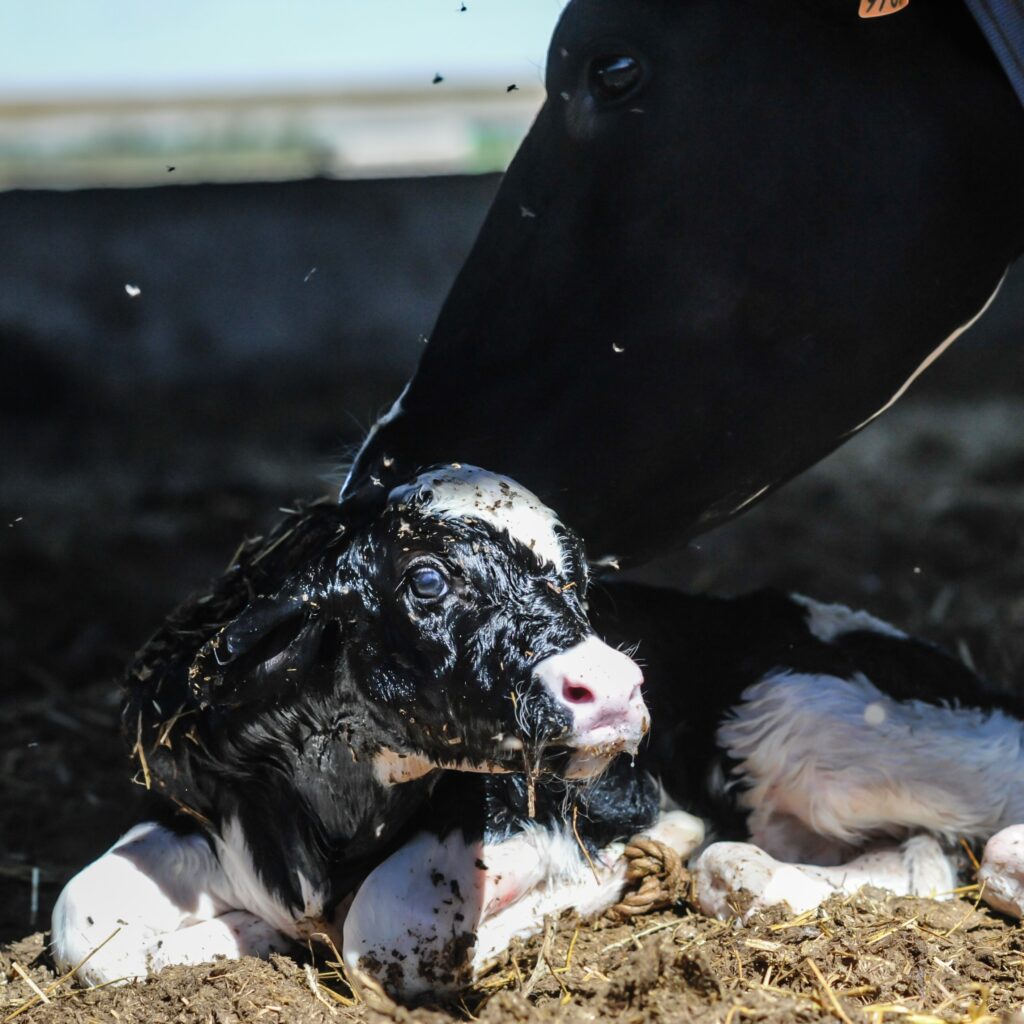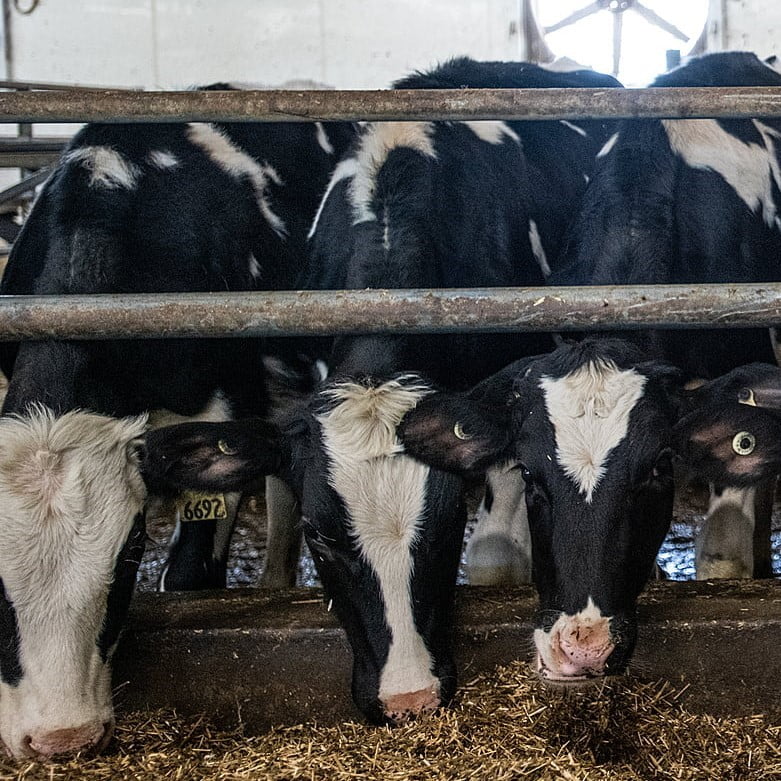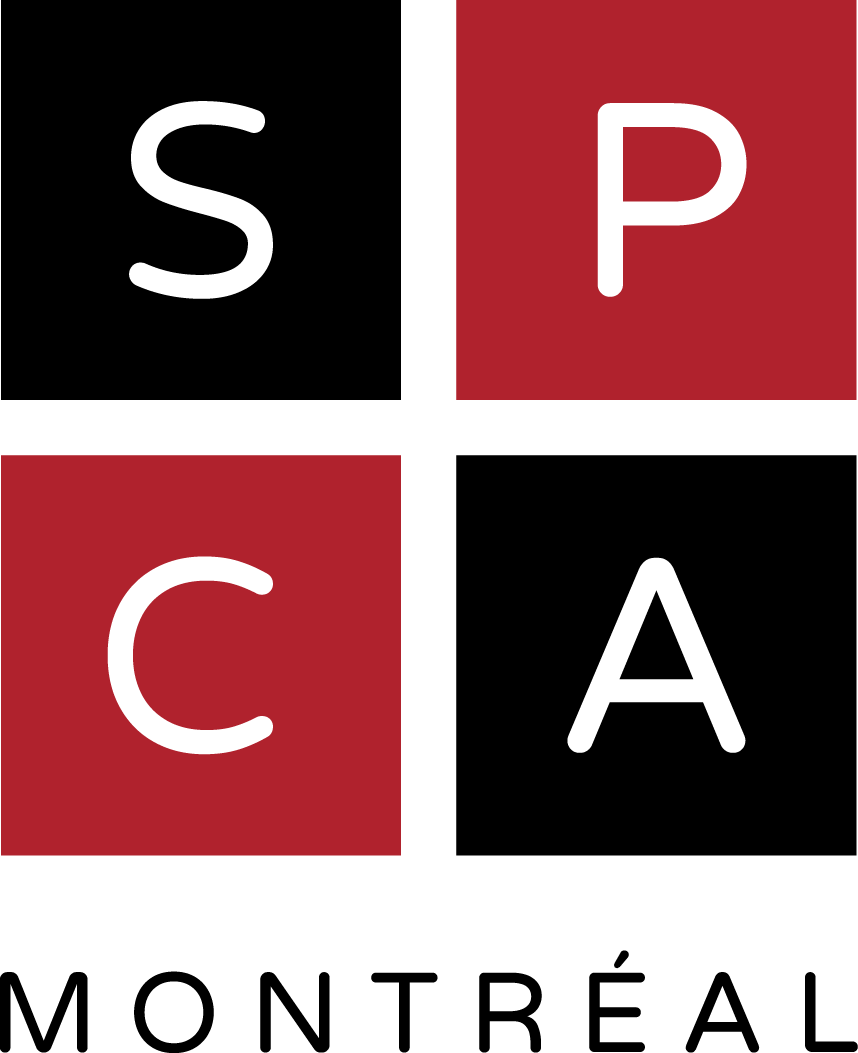In Canada, nearly one million cows are used in the dairy industry, including about 350,000 just in Quebec.¹
These social and intelligent animals are, for the most part, kept chained by the neck in tie stalls. They also undergo systematic mutilation.
To produce milk for human consumption, they must give birth to a calf every year, who is usually taken away from them at birth. After five years of milk production, they are sent to auction and then to slaughter, to be killed for their meat.
Regulations governing the treatment of dairy cows in this country are very limited. In keeping with its mission to protect animals and raise public awareness, the Montreal SPCA is working to improve the protection of dairy cows.
Deprived of freedom of movement
The vast majority of dairy cows spend their lives in tie stalls, a housing system in which dairy cows are kept permanently indoors, tethered by the neck. Severely restricting their movement and preventing them from even turning around, this practice is used on 75% of Canadian dairy farms2 and is even more widespread in Quebec, with 90% of farms.
Currently, some 315,000 Quebec cows—the vast majority of cows—do not have access to the outdoors and cannot satisfy their most basic behavioural needs, such as moving around freely or socializing with their herd.
Fig. 1 Dairy cows in loose housing on a Quebec farm.
Complex social bonds
Cows need to groom each other, and this must be with individuals of their choice. This ensures social cohesion and friendly interaction within the herd, but they are currently deprived of the opportunity to express this behaviour. A study on free-range herds reported that pregnant cows receive more signs of affection and revealed they have favourite partners for grooming and whose presence calms their heart rate.3
Deprived of opportunities for interactions, grazing, moving freely and choosing the individuals they want to be in contact with, cows tied up in their stalls exhibit stereotypical behaviours, including repetitive biting or licking of metal bars—both indicators of psychological distress.4
Rich cognitive and emotional abilities
Current science demonstrates that cows have an interest in play (similar to that observed in other mammals, such as dogs) as well as the ability to experience a wide range of complex emotions, including emotional responses to learning (beyond responding to simple positive or negative stimuli), cognitive biases and emotional contagion within groups of cows. This suggests that cows are capable of sophisticated cognitive processes such as self-awareness and empathy.5
A recent study includes cows in the list of animals who can laugh: vocalizations characteristics to their species demonstrate positive emotion and occur in the context of play.6
Systematic mutilations
In industrial dairy production, cows undergo mutilations, such as disbudding (cauterization of horn buds at the beginning of growth) and thermal removal of udder hair with a cold flame.
The road to slaughter
After being used to produce milk all their lives, cows are usually sent to be sold at auction at about five years of age, and then to slaughter. Cull cows—those who no longer produce enough milk—make up the majority of ground beef sold to consumers. Typically, 25% of a farm’s dairy cows are sent to slaughter each year, which represents approximately 250,000 cull cows in Canada annually.
Fig. 2 A dairy cow in a truck on her way to slaughter.
A cow naturally produces milk to feed one calf every year at a rate of about 4 litres per day. In the dairy industry, a dairy cow is expected to produce enough milk to feed 125 people, or up to 30 litres per day.7
After about five years, cull cows, now exhausted by such a demanding production, are transported over long distances to be slaughtered.
For cows who have spent their lives in tie stalls and therefore have not developed their muscles (as is the case for the majority of Quebec cows), the jostling and standing for long periods they must endure during transportation over long distances can be very difficult.
Cows are not currently required to be dried off from their milk production to go to slaughter. They are routinely transported over long distances while still lactating, causing discomfort and increasing the risk of developing painful physical conditions, such as mastitis, an inflammation of the udders.
The separation of cow and calf, a key aspect of dairy production
Like all mammals, cows must give birth in order to produce milk. The standard practice in the dairy industry is to remove the calf from their mother within the first few hours of life. The calf is then fed a commercial milk replacement and the cow is milked to preserve her milk for human consumption. The bucolic image of mother and calf running freely in a field is therefore hardly standard practice in Canada.
Here are some images shot on a Canadian farm in 2021.
Thanks to Animal Justice for providing this footage.
The maternal instinct: What does the science say?
Throughout their five-year life, dairy cows will give birth about once a year, and their calf will be taken away almost immediately each time. Following this separation, cows make very specific vocalizations8, bellowing for days.
Eva Mutua, a graduate researcher in Applied Animal Behaviour and Animal Welfare at the Royal Dick Vet School, University of Edinburgh, says that cows are particularly keen to express maternal behaviours. When they are given the opportunity, caring for their calves significantly improves their welfare. In some cases, it even increases their milk production.9 The separation of mother and calf, on the other hand, causes significant and repeated psychological suffering to dairy cows and their calves.
The documented benefits of keeping calves with their mother
Les avantages d’une proximité prolongée entre la vache et son veau sont maintenant largement documentés. D’abord, les vaches qui allaitent leurs veaux présentent moins de mastites que les vaches traites à la machine.10 On note aussi un taux de croissance plus élevé et une diminution de la mortalité chez les veaux restés près de leur mère. On observe également que le veau développe de meilleures compétences sociales lorsqu’il a la chance de demeurer près de sa mère.11
The forced separation of cow and calf that has become the norm in Canada is a very recent practice, dating back only about 100 years. Indeed, as Kerstin Barth, a researcher at the Thünen Institute, tells us, “Cows and calves have been kept together for thousands of years. Producers should be familiar with this type of rearing, but it is as if we have forgotten how dairy cattle behave together and how they react when they are separated.”12
Veal, a by-product of the dairy industry
In the dairy industry, male calves are of no use for milk production and so are sold for meat. Quebec produces the majority of milk-fed calves in Canada. In 2020 alone, nearly 160,000 were slaughtered.
After calves have been separated from their mother, the norm in Canada is to keep the baby in an individual pen for 140 to 170 days (4 to 6 months).13 However, studies indicate that the complete isolation of young calves induces significant stress in these social animals and does not allow for normal behavioural development.14
Here is a glimpse into calf housing on a Canadian farm in 2021.
Thanks to Animal Justice for providing this footage.

How is the treatment of cows regulated?
At the provincial level, farmed animals—including dairy cows—are excluded from the main protections of the Animal Welfare and Safety Act, provided they are treated according to standard industry practices.
Yet some of these, such as the tethering of cows, are inherently incompatible with basic animal welfare.
At the federal level, the National Farm Animal Care Council (NFACC) publishes codes of practice.
These nationally developed guidelines set out minimum acceptable standards for the care and handling of animals raised for human consumption. They are not legally binding, but they do reflect industry consensus on what is and is not acceptable for animal welfare. However, NFACC is primarily made up of members from the industry itself. For example, of the 21 members of the committee responsible for the review of the Code of Practice for the Care and Handling of Dairy Cattle, only one was from an animal welfare organization!
The Codes are revised periodically, a process that includes a public consultation period.
What you can do to help cows
Here are a few ways you can help cows:
Sign to protect them. If you haven’t already done so, we encourage you to sign our manifesto asking for a regulatory framework governing the living conditions of cows and other farmed animals in Quebec, endorsed by nearly 40 well-known figures in Quebec. This manifesto aims to amend laws so that these animals can finally receive the protections they deserve.
Learn more about pigs by listening to the episode L’amitié chez les vaches from our French-Language podcast Au nom des animaux. It is also available on Google Podcasts, Spotify and Apple Podcasts. And encourage your friends and family to listen to it!
Another way to help change the living conditions of animals like cows is to write to your Member of the National Assembly.
The most effective way to help cows is to reduce or eliminate your consumption of beef products. This way, you tackle the problem at its source. You can also advocate for the adoption of policies that promote a sustainable food transition.
What is the SPCA doing to protect cows?
Given the development of scientific knowledge on the welfare of animals raised for food, and the public’s growing concern over the living conditions of these animals, the Montreal SPCA calls for a fundamental rethinking of the dairy industry’s current practices.
There is consensus on certain minimum requirements for the living conditions of dairy cows. A 2019 survey by the National Farm Animal Care Council (NFACC) reveals that access to the outdoors, ability to express natural behaviours and freedom from permanent physical restraint are Canadians’ top priorities when it comes to dairy cow welfare.

However, the Code of Practice continues to allow the use of tie stalls and the isolation of calves.
In spring 2023, the new NFACC Code of Practice was released. We publicly emphasized that, despite certain advancements, its recommendations remain largely insufficient.
In the winter of 2022, the Montreal SPCA provided detailed comments on the draft Code of Practice for the treatment of dairy cows. The SPCA also conducted an important awareness campaign inviting citizens to provide constructive feedback to NFACC, which involved providing a summary of the key issues regarding the welfare of dairy cows. This campaign helped expose the issue of dairy cow welfare in the media, including this article in La Presse and this column in Métro.
For several years, the Montreal SPCA has maintained pressure on the Government of Québec to provide basic legal protection for farmed animals, including via representations made during consultations on bills such as Bill 51 in 2012 and Bill 54 in 2015, as well as through its Animal Wrongs campaign in 2018.
The Montreal SPCA’s mission is to foster compassion for all sentient beings.
Farmed animals are a particularly vulnerable category of sentient beings given their commodification in a self-regulated industry. They also represent by far the largest number of exploited animals in Quebec.
In addition to demanding that government provide these animals with a minimal amount of protection, an effective way to reduce their suffering is to choose plant-based alternatives to animal products.
Crédits photo :
- Banner photo: © Jo-Anne McArthur/Djurrattsalliansen/We Animals Media
- Fig. 1 Photography: © Jo-Anne McArthur/Animal Equality/We Animals Media
- Fig. 2 Photography: © Julie LP/We Animals Media
- Fig. 3 Photography: © Jo-Anne McArthur/Animal Equality/We Animals Media
- Fig. 4 Photography: © Jo-Anne McArthur/We Animals Media
- 1 https://www.quebec.ca/agriculture-environnement-et-ressources-naturelles/agriculture/industrie-agricole-au-quebec/productions-agricoles/production-lait-vache
- 2 https://www.dal.ca/faculty/agriculture/oacc/en-home/organic-science-cluster/OSCII/theme-d/activity-d43.html
- 3 https://faunalytics.org/the-social-importance-of-cow-licks/
- 4 https://www.sciencedirect.com/science/article/abs/pii/0168159194901481
- 5 https://www.animalbehaviorandcognition.org/uploads/journals/17/AB&C_2017_Vol4(4)_Marino_Allen.pdf
- 6 https://gabryant.scholar.ss.ucla.edu/wp-content/uploads/sites/20/2021/05/Play_vocals_Bioacoustics_2021.pdf
- 7 https://lait.org/la-ferme-en-action/la-sacree-vache/
- 8 https://www.sciencedirect.com/science/article/abs/pii/S0168159100001283?via%3Dihub%22%20%5Ct%20%22_blank
- 9 https://www.ed.ac.uk/chaplaincy/introducing-the-abundant-academy/compassion-for-our-times
- 10 https://www.sciencedirect.com/science/article/abs/pii/S0168159101001174?via%3Dihub
- 11 https://www.sciencedirect.com/science/article/abs/pii/S0168159112002511?via%3Dihub
- 12 https://ici.radio-canada.ca/nouvelle/1846549/lait-vache-veaux-meres-bien-etre-animal
- 13 https://agriconseils.qc.ca/wp-content/uploads/2015/11/201508-17-Industrie-du-veau-lourd-au-Qu%C3%A9bec.pdf
- 14 https://cdnsciencepub.com/doi/full/10.1139/cjas-2019-0031






